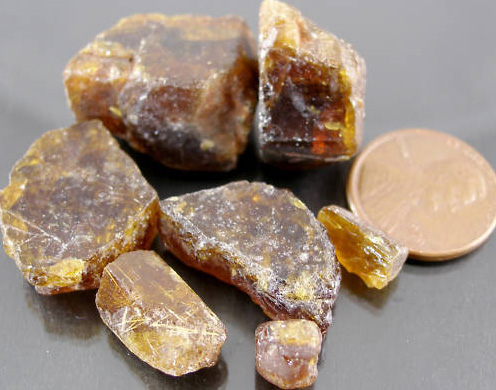Bastnaesite
Bastnaesite, sometimes known as Bastnäsite, is a rare carbonate-fluoride mineral first discovered in 1838 by Wilhelm Hisinger, a Swedish chemist. Bastnaesite derives its name from the Bastnas mine in Vastmanland, Sweden, where the mineral was first discovered. The name was given by Wilhelm Hisinger who also incidentally owned the Bastnas mine. Subsequently Hisinger along with few other chemists also discovered other minerals in the Bastnas mine.

Bastnaesite
rough
Image © supplied by Woodmansee* Gems
Bastnaesite's chief distinction is that it is one of the most significant sources of the element cerium and other rare elements. The other chief resource for these elements is the mineral monazite.
Bastnaesite has the general chemical formula (Ce,La,Y)CO3F, however is generally subdivided into three types: Bastnaesite-(Ce) with a formula of (Ce, La)CO3F, bastnaesite-(La) with a formula of (La, Ce)CO3F, and bastnaesite-(Y) with a formula of (Y, Ce)CO3F. In general the elements cerium, lanthanum and yttrium are present but the mineral is subcategorized depending on which of the rare earth elements is present. [1] Despite the varying proportions of Yttrium and Lanthanum in the crystals of Bastnaesite, the rare earth element Cerium is dominant in all the three classifications .
Bastnaesite is weakly radioactive due to the presence of large proportions of rare earth element Cerium.
Bastnaesite typically occurs naturally in a reddish brown color. The crystals of Bastnaesite can also occur in the honey yellow color though this formation is quite rare. The crystals of Bastnaesite occur as thick and tabular crystals and are characterized by massive striations on the crystals. Bastnaesite can also be granular in nature. The crystal system of Bastnaesite is hexagonal with uneven fracturing. The uneven fracturing makes the crystals of Bastnaesite quite brittle and hence can be broken with bare hands. The hardness of the Bastnaesite crystals is between 4 and 5 on the Moh’s hardness scale.
The crystals of Bastnaesite range from being completely transparent to translucent with a vitreous luster which changes to a pearly sheen on the fractures of the crystals. The crystals of Bastnaesite are soluble in hot and concentrated acids.
Bastnaesite is not typically considered a gemstone / faceted, however better quality examples of the crystals may sometimes be seen as collectors' minerals in their natural form. The chief use of bastnaesite is industrial, and the rare earth elements it contains are extracted through a multi-stage process and used in numerous ways in a wide variety of modern technologies: For example, europium, found in small amounts in bastnaesite and monazite, found much use in the 20th century in the red phosphor used in color televisions. [1]
Bastnaesite - Occurrence:
Bastnaesite is considered a rare mineral. The type locality is the Bastnäs mines, Riddarhyttan, Skinnskatteberg, Västmanland, Sweden.
Large deposits of bastnaesite were found in 1949 at Mountain Pass, San Bernardino County, California. This significant find became the world's leading source of lanthanides from the 1960s to the 1980s. Other significant finds were made in China and Africa, with China becoming a major world supplier of lanthanides. Since then, the huge deposit at Bayan Obo, Inner Mongolia has become the world's leading source of lanthanides.
Bastnaesite has also been found in the Balkan regions, Greece and in the deposits of karst bauxite in Hungary. The crystals of Bastnaesite are also found in carbonatites deposits, hence trace amounts of Bastnaesite were found in Norway, Mongolia, Turkey, Malawi and Colorado, USA. Bastnaesite crystals were also found in granite deposits in Russia and Canada. Many hydrothermal sources have also reported to contain trace amounts of Bastnaesite.
Bastnaesite is usually found in rare earth element deposits in igneous rocks. The biggest naturally occurring crystals of Bastnaesite were found in Burundi and in Pakistan. Bastnaesite has been found in association with zinc [2], allanite, cerite, tysonite [3], barite, calcite, dolomite, fluocerite, and albite, monazite and magnetite. [1]
Bastnaesite - Sources Referenced:
[1] http://en.wikipedia.org/wiki/Bastnäsite
[2] http://www.thefreedictionary.com/bastnaesite
[3] http://www.britannica.com/EBchecked/topic/55639/bastnaesite
Back to the Gemstones List home page - over 160 gemstones explored!
Please feel free to link to this page - copy / paste the text below: (click to select)
Privacy Policy | Cookie Policy | GDPR | About This Site / Terms

© gemstoneslist.com


